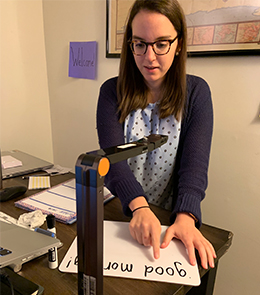Alumni teachers embrace the linguistic and cultural diversity of their bilingual students through family engagement

When schools transitioned to online learning in March, teachers across the country had to quickly learn how to fit their classrooms into each student’s home. For ESL and bilingual education teachers, the extra challenge of the linguistic and cultural diversity of students put additional pressure on teachers to keep students engaged at home as well as their families. As students’ homes turned into their classrooms, and teachers became a part of each students’ home life, ESL teachers had the challenging task of incorporating students’ cultural backgrounds into online learning.
Kayla Cardona-Hernandez, who graduated from William & Mary in 2017 describes the experience as eye-opening. She is in her second year teaching at Richneck Elementary School in Newport News, Virginia. Even though students may not have the materials they need, her priority is building a relationship with her students to make school more enjoyable.
Her experiences in the classroom inspired her to become a teacher in bilingual education.
“I never had a teacher that looked like me, or that I connected with based on similar experiences. I wanted students to feel that sense of community and that being different was okay and something to celebrate.”
She says that she felt that sense of purpose and connection since her first time in the classroom, and the relationships she forms with students are the biggest perk of the job.
The biggest challenge for her is a feeling of not reaching all of her students and meeting their individual needs. Engaging families in their student’s learning is exacerbated by their linguistic and cultural diversity, but making herself available through independent conferences, invitations to join Zoom classes, and offering supplies to families helps make families feel more a part of their child’s education.
Family engagement is also how Eliana Marrs M.A.Ed. ‘19, a bilingual education teacher in Prince William County, responds to the linguistic and cultural diversity among students and families. Marrs engages with students through email and phone calls, and her school’s Parents as Educational Partners program allows parents to take English classes online and learn about how to support their children through school while connecting with their children’s teachers.
Marrs’ mother’s Colombian roots influence her identity as a Colombian-American, she says. She became interested in bilingual education while working in Blacksburg, Virginia, where she began to see how many more teachers were needed to support Emerging Bilingual students. Now, she is in her second year of teaching in bilingual education since graduating from William & Mary with a master’s degree in English as a Second Language and Bilingual Education.
She describes herself as somewhat of a perfectionist when it comes to teaching, but had to readjust her expectations and be more open to trial and error in the virtual classroom setting. Her approach of accomplishing one small task at a time so that little successes build upon each other takes time, but she has been able to see her work pay off. She also sees her role as both a teacher and a student at times.
“One of the biggest blessings to me has been learning from other teachers, leaders, and students at my school,” she says.
“In my first year of teaching, I was mentored and encouraged by veteran teachers and administrators. This has certainly continued in my second year of teaching and has helped me continue to grow and improve as an educator. Not only have I learned from my colleagues, but also my students. They have helped me to know what works for engaging with students and learn more about them as people.”
Bringing Latinx culture into the learning environment helps engage students and provides opportunities for students and teachers to learn from one another. Even something as simple as sharing their favorite food can connect students over a shared culture, Cardona-Hernandez says. She also incorporates books with characters who resemble the students who read them, which allows students to see themselves reflected in the stories.
“I love to incorporate Latinx culture into the classroom, but many times it is the students teaching me about what Latinx culture means to them whether it be stories, food, or books they love to share with me so I get to become the student and learn from them,” Marrs adds.
“Any chance we get, we share about connections we are making to culture and experiences the students have.”